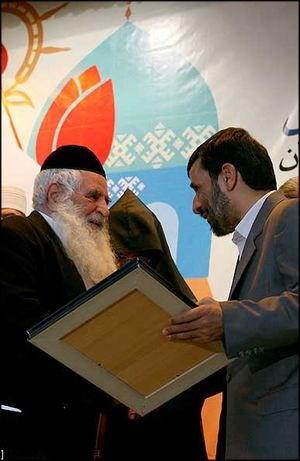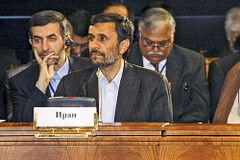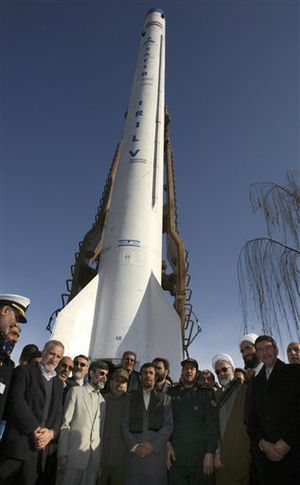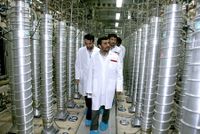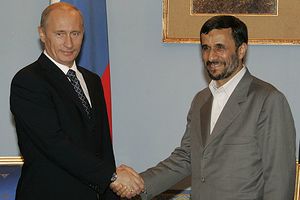محمود أحمدينژاد
| محمود أحمدي نجاد Mahmūd Ahmadinejād محمود احمدینژاد | |
|---|---|

| |
| سادس رئيس لإيران | |
| في المنصب 3 أغسطس 2005 – 3 أغسطس 2013 | |
| نائب الرئيس | پرڤيز داوودي اسفنديار رحيم مشايي محمد رضا رحيمي |
| زعيم | علي خامنئي |
| سبقه | محمد خاتمي |
| خلفه | حسن روحاني |
| خامس عمدة طهران | |
| في المنصب 20 يونيو 2003 – 3 أغسطس 2005 | |
| سبقه | محمد حسن مالكمدني |
| خلفه | محمد باقر قاليباف |
| تفاصيل شخصية | |
| وُلِد | 28 أكتوبر 1956 أردان، طهران، إيران |
| الحزب | تحالف بناة إيران |
| انتماءات سياسية أخرى |
جمعية المهندسين الإسلامية |
| الزوج | |
| الأنجال | 3 |
| الإقامة | Square 72, Narmak, Tehran[1] |
| الجامعة الأم | جامعة إيران للعلوم والتكنولوجيا |
| المهنة | مهندس مدني |
| الدين | مسلم |
| التوقيع | 
|
| الموقع الإلكتروني | http://www.president.ir |
| الخدمة العسكرية | |
| الولاء | |
| الخدمة/الفرع | |
| سنوات الخدمة | 1986–1988[2][3] |
| الرتبة | None[أ] |
| الوحدة | Hamzeh Headquarters[2] |
| قاد | Combat engineering Unit, 6th Special Division[3] |
| المعارك/الحروب | Iran–Iraq War |
| الخلفية الأكاديمية | |
| الأطروحات | |
| المشرف على الدكتوراه | Hamid Behbahani |
| مشرفون أكاديميون آخرون | Ali Mansour Khaki Gholamreza Shirazian Jalil Shahi |
| العمل الأكاديمي | |
| المجال | Civil engineering |
| المجال الفرعي | Traffic engineering |
| المؤسسة | Iran University of Science and Technology |
محمود أحمدي نجاد (فارسية: محمود احمدینژاد [mæhmuːd(-e) æhmædiːneʒɒːd] (![]() استمع),[ب][5][6] و. محمود صباغيان[7] (فارسية: صباغیان) في 28 أكتوبر 1956)[8][9]، هو سياسي إيران وسادس رؤساء إيران من 2005 حتى 2013. كان أيضاً الزعيم السياسي الرئيسي في تحالف بناة إيران الإسلامية، تحالف الجماعات السياسية المحافظة في البلاد. He is currently a member of the Expediency Discernment Council. He was known for his hardline views and nuclearisation of Iran. He was also the main political leader of the Alliance of Builders of Islamic Iran, a coalition of conservative political groups in the country, and served as mayor of Tehran from 2003 to 2005, reversing many of his predecessor's reforms.
استمع),[ب][5][6] و. محمود صباغيان[7] (فارسية: صباغیان) في 28 أكتوبر 1956)[8][9]، هو سياسي إيران وسادس رؤساء إيران من 2005 حتى 2013. كان أيضاً الزعيم السياسي الرئيسي في تحالف بناة إيران الإسلامية، تحالف الجماعات السياسية المحافظة في البلاد. He is currently a member of the Expediency Discernment Council. He was known for his hardline views and nuclearisation of Iran. He was also the main political leader of the Alliance of Builders of Islamic Iran, a coalition of conservative political groups in the country, and served as mayor of Tehran from 2003 to 2005, reversing many of his predecessor's reforms.
An engineer and teacher from a poor background,[10] he was ideologically shaped by thinkers such as Navvab Safavi, Jalal Al-e-Ahmad, and Ahmad Fardid.[11] After the Iranian Revolution, Ahmadinejad joined the Office for Strengthening Unity.[12] Appointed a provincial governor in 1993, he was replaced along with all other provincial governors in 1997 after the election of President Mohammad Khatami and returned to teaching.[13][14] Tehran's council elected him mayor in 2003.[15] He took a religious hard line, reversing reforms of previous moderate mayors.[16] His 2005 presidential campaign, supported by the Alliance of Builders of Islamic Iran, garnered 62% of the runoff election votes, and he became president on 3 August 2005.[17][18]
During his presidency, Ahmadinejad was a controversial figure both in Iran and worldwide. He was criticized domestically for his economic policies,[19] and was accused of disregard for human rights by organizations in North America and Europe.[20] Outside of Iran, he was criticized for his hostility towards countries including Israel, Saudi Arabia, the United Kingdom, and the United States and other Western and Arab states. In 2007, Ahmadinejad introduced a gasoline rationing plan to reduce the country's fuel consumption and cut the interest rates that private and public banking facilities could charge.[21][22][23] He supports Iran's nuclear program. His election to a second term in 2009 was widely disputed,[24][25] and led to widespread protests domestically and criticism from Western countries.[26]
During his second term, Ahmadinejad experienced a power struggle with reformers and other traditionalists in Parliament and the Revolutionary Guard,[27] as well as with Supreme Leader Ali Khamenei,[28] over his dismissal of intelligence minister Gholam-Hossein Mohseni-Eje'i and his support for his controversial close adviser, Esfandiar Rahim Mashaei.[29] On 14 March 2012, Ahmadinejad became the first president of the Islamic Republic of Iran to be summoned by the Islamic Consultative Assembly (parliament) to answer questions regarding his presidency.[30][31] Limited to two terms under the current Iranian constitution, Ahmadinejad supported Mashaei's campaign for president.[27] In 2013, Hassan Rouhani was elected as Ahmadinejad's successor.
On 12 April 2017, Ahmadinejad announced that he intended to run for a third term in the 2017 presidential election, against the objections of Supreme Leader Khamenei.[32] His nomination was rejected by the Guardian Council.[33][34] During the 2017–18 Iranian protests, Ahmadinejad criticized the current government of Iran. He made a second attempt at registering to run for the 2021 presidential election, and was rejected again by the Guardian Council.[35] He registered as a candidate in the 2024 Iranian presidential election,[36] but was subsequently rejected.[37]
. . . . . . . . . . . . . . . . . . . . . . . . . . . . . . . . . . . . . . . . . . . . . . . . . . . . . . . . . . . . . . . . . . . . . . . . . . . . . . . . . . . . . . . . . . . . . . . . . . . . . . . . . . . . . . . . . . . . . . . . . . . . . . . . . . . . . . . . . . . . . . . . . . . . . . . . . . . . . . . . . . . . . . . .
النشأة والتعليم
ولد محمود أحمدی نجاد في عام 1956 في قرية ارادان من توابع مدينة كرمسار جنوبی [طهران]. وقد سكن في مدینة طهران مع أسرته منذ السنة الأولي من عمره وأمضي مراحل دراسته الإبتدائية والمتوسطة والثانوية في هذه المدينة. وأحرز المرتبة 132 في الاختبار العام للقبول في الجامعة في عام 1975م حيث بدأ دراسته العليا في قسم هندسة تخطیط المدن في جامعة العلم والصناعة. وفي عام 1986 تم قبوله في مرحلة الماجستير في تلك الجامعة ثم إنضم في عام 1989 إلي الهيئة التدریسیة لكلية هندسة تخطیط المدن في الجامعة نفسها. وفي عام 1997. نجح في الحصول علي شهادة دكتوراه هندسة التخطيط للشحن والنقل من الجامعة ذاتها. والدكتور أحمدی نجاد لديه إلمام باللغة الانجليزية وخلال سنوات تدريسه في هذه الجامعة وتأليفه للمقالات وكتابته العديد من الأبحاث العلمية قام بالإشراف علي العشرات من أطروحات الماجستير والدكتوراه الأخصائیة في مختلف مجالات هندسة تخطیط المدن والطرق والشحن والنقل. وقبل انتصار الثورة الإسلامية شارك الدكتور أحمدی نجاد باعتباره طالباً جامعياً حينذاك في الإجتماعات الدينية والسياسية وتعرّف علی الأجواء السياسية في المجتمع. وبعد انتصار الثورة الاسلامية وبالنظر إلي حضوره في الجامعة، كان أحمدی نجاد من مؤسسي الرابطة الاسلامية لطلّاب جامعة العلم والصناعة في إيران. [38]
مناصب ادارية وأكاديمية
- حاكم مدينة ماكو الإیرانیة.
- حاكم مدينة خوي الإیرانیة.
- مستشار محافظ كردستان.
- المستشار الثقافي لوزيرالثقافة و التعليم العالي في عام 1993.
- محافظ اردبيل منذ 1993 م حتي 1997.
- عضو الهيئة التدریسیة لكلية هندسة تخطیط المدن في جامعة العلم و الصناعة منذ 1989 م حتي الآن.
- رئيس بلدية طهران منذ 2003 حتي 2005.
- تم انتخابه في الدورة التاسعة لانتخابات رئاسة الجمهورية في عام 2005 من قبل الشعب الايراني رئيساً للجمهورية الإسلامية الإيرانية وتم انتخابه کرئیس الجمهوریة للمرة الثانیة فی عام 2009 حتى الآن.
بالإضافة إلي التدريس والإشراف علي أطروحات الطلبة والقيام بالشؤون التنفيذية مارس الدكتور أحمدی نجاد أنشطته في المجالات التالية:
- العمل الصحافي حيث كتب العديد من المقالات السياسية والاجتماعية والثقافية والاقتصادية.
- المدير المسئول لصحيفة "همشهري" حيث قام بإصدار صحيفة همشهري المنطقة في 22 منطقه من مناطق طهران وكذاهمشهري المسافر وهمشهري الدبلوماسية و همشهري الشباب و همشهري الشهرية وملحق الفكر وملحق الطلبة الجامعيين الخ.
- من مؤسسي رابطة الأنفاق في إيران وأحد أعضائها.
- عضو رابطة المهندسين المدنيين في ايران.
- عضو في أول لجنة مركزية للرابطة الاسلامية لطلاب الجامعه في جامعة العلم والصناعة في ايران.
- عضو في أول لجنة مركزية لاتحاد الرابطات الإسلامية لطلاب الجامعات ومؤسسات التعليم العالي في البلاد.
حصار السفارة
الروايات التي أشارت إلى أن أحمدي نجاد كان أحد المشاركين في حصار السفارة الامريكية قي طهران 1980 أصبحت حاليا غير ذات مصداقية. عمله السياسي المبكر بعد الثورة الإسلامية، أحمدي نجاد أصبح عضوا في مكتب تعزيز الوحدة، وهي منظمة وضعت لمنع الطلاب من التعاطف أو التحالف مع مجاهدي خلق. أول مرة تولى فيها منصبا سياسيا كان رئيسا غير منتخب على كل من مقاطعتي ماكو وكوى في محافظة أذربيجان الغربية خلال 1980. ثم أصبح مستشارا للحاكم العام لمقاطعة كردستان لمدة عامين. وخلال دراسات للدكتوراه في طهران، عين حاكما عاما لمقاطعة أردبيل في الفترة من 1993و حتى استبعده محمد خاتمي في عام 1997.حيث عاد أحمدي نجاد بعد ذلك إلى التدريس. عمدة طهران
في عام 2003، كانت نسبة مشاركة المحافظين المرشحين من تحالف بناة ايران الإسلامية إلى مجلس مدينة طهران 12 في المئة فقط. ومع ذلك، عين المجلس أحمدي نجاد المحافظ رئيساً لبلدية طهران.
عندما أصبح رئيساً للبلدية، قام أحمدي نجاد بعكس جميع التغييرات التي أجراها رؤساء البلديات المعتدلون والإصلاحيون السابقون. فقد وضع أسساً دينية للأنشطة بالمراكز الثقافية التي تأسست لديهم، وفصل استعمال المصعد للرجال والنساء في المكاتب العامة، واقترح أن يتم دفن الأشخاص الذين قتلوا في الحرب العراقية الايرانية بالميادين الكبرى في طهران. كما عمل على تحسين نظام المرور ووضع تركيزاً كبيراً على الأعمال الخيرية، مثل توزيع الحساء المجاني على الفقراء.
و بعد انتخابه للرئاسة تم قبول استقالة أحمدي نجاد من رئاسة بلدية طهران في 28 حزيران/يونيو 2005. بعد العمل سنتين كعمدة، كان نجاد واحداً من 65 حاكم ولاية في العالم في عام 2005، تم اختيارهم من بين 550 مرشحاً، تسعة منهم فقط من آسيا. وكان من بين الثلاثة المرشحين بقوة لقائمة العشرة الأوائل، ولكن استقالته من منصبه جعلته غير مؤهل لذلك. الرئاسة
انتخابات الرئاسة
تقدم سنة 2003 إلى الانتخابات البلدية في طهران حاملا لقب صديق الشعب. تم انتخابه رغم نسبة المشاركة الضعيفة (13%). اصطدم في البداية بأنصار الرئيس خاتمي والتيار الإصلاحي عندما قام بإزالة كل مظاهر الجديدة التي أقرها حكام طهران الإصلاحيون السابقون، عمل على إدخال العناصر المحافظة إلى الإدارة الجديدة. بسبب مواقفه قام الرئيس خاتمي يمنعه من حضور مجلس الوزراء والذي جرت العادة أن يكون رئيس بلدية إيران حاضرا فيه بصفة مراقب.
انتخابات 2005
تنافس في 17 يونيو 2005 م في الانتخابات الرئاسية، وأحدث المفاجأة بفوزه في الدور الاول بنسبة 19.5% من الأصوات، واحتل المركز الثاني وراء الرئيس السابق هاشمي رفسنجاني. يوم 24 يونيو تم إجراء الدور الثاني من الانتخابات وأمام دهشة الجميع أعلن عن فوز محمود أحمدي نجاد بمقعد رئاسة الجمهورية في إيران.
2005 cabinet appointments
| Ministry | Minister |
|---|---|
| Agriculture | Mohammad Reza Eskandari |
| Commerce | Masoud Mir Kazemi |
| Communication and Information Technology | Mohammad Soleimani |
| Cooperatives | Mohammad Abbasi |
| Culture and Islamic Guidance | Hossein Saffar Harandi |
| Defense and Armed Forces Logistics | Mostafa Mohammad Najjar |
| Economy and Financial Affairs | Hossein Samsami |
| Education | Alireza Ali Ahmadi |
| Energy | Parviz Fattah |
| Foreign Affairs | Manoucher Mottaki |
| Health and Medical Education | Kamran Bagheri Lankarani |
| Housing and Urban Development | Mohammad Saeedikia |
| Industries and Mines | Aliakbar Mehrabian |
| Intelligence | Gholam Hossein Mohseni-Ejehei |
| Interior | Mostafa Pour-Mohammadi[39] |
| Justice | Gholam Hossein Elham |
| Labour and Social Affairs | Mohammad Jahromi |
| Petroleum | Gholam Hossein Nozari |
| Roads and Transportation | Hamid Behbahani |
| Science, Research, and Technology | Mohammad Mehdi Zahedi |
| Welfare and Social Security | Abdolreza Mesri |
انتخابات 2009
الانتخابات الرئاسية الإيرانية 2009، هي انتخابات رئاسية عقدت في إيران في 12 يونيو، 2009.[40] وهي الانتخابات الرئاسية العاشرة في البلاد. ويشغل محمود أحمدي نجاد، الذي يعاد ترشيحه مرة أخرى لمنصب الرئاسة. وحاولت حركة الإصلاح الإيرانية توحيد صفوفها خلف مرشح واحد. الرئيس السابق محمد خاتمي كان من أبرز المرشحين للمنافسة لحين خروجه وتأييد رئيس الوزراء مير حسين موسوي.[41] المتحدث السابق باسم المجلس مهدي كروبي، وهو من الإصلاحيين، أيضا يخوض الإنتخابات الرئاسية.
احتجاجات الانتخابات الإيرانية 2009
احتجاجات الانتخابات الإيرانية 2009، هي احتجاجات أعقبت الانتخابات الرئاسية الإيرانية 2009 اعتراضا على تزوير الإنتخابات وتضامنا مع مرشح الرئاسة مير حسين موسوي ، واندلعت في 21 يونيو في طهران والمدن الإيرانية الرئيسية ومدن أخرى حول العالم.[42]
وقد أطلق على تلك الاحتجاجات عدة ألقاب منها الثورة الخضراء بسبب اختيار موسوي للون الأخضر في حملته الانتخابية ، والصحوة الفارسية.[43] وكرد على تلك الاحتجاجات، احتشدت مجموعات أخرى مؤيدة لانتصارات محمود أحمدي نجاد.[43]
ووصف بعض المحللون نتائج الانتخابات تلك المثيرة للجدل بالانقلاب.[44][45][46] أو كما بالفارسية Anno Persarum 1388 خرداد انقلاب 22 يونيو). وقد إدعى الثلاث مرشحين بأن هناك تلاعب في الأصوات الانتخابية، وقدم كل من محسن رضائي ومير موسوي شكاوى رسمية. وأعلن موسوي أنه "لن يستسلم لهذا التلاعب" وقدم شكوى رسمية ضد النتائج لمجلس صيانة الدستور في 14 يونيو.[43]
2009 cabinet appointments
. . . . . . . . . . . . . . . . . . . . . . . . . . . . . . . . . . . . . . . . . . . . . . . . . . . . . . . . . . . . . . . . . . . . . . . . . . . . . . . . . . . . . . . . . . . . . . . . . . . . . . . . . . . . . . . . . . . . . . . . . . . . . . . . . . . . . . . . . . . . . . . . . . . . . . . . . . . . . . . . . . . . . . . .
التوجهات

يعتبر أحمدي نجاد محسوبا على التيار المحافظ. وهو مقرب من مرشد الثورة علي خامنئي. ويحظي بتأييد واسع داخل أوساط الحرس الثوري و ميليشيا البسيج. أراد في مؤتمر فلسطين، ببساطة محو إسرائيل من الأرض. يرفض التدخل الأجنبي في السياسة الداخلية، وقد عبر عن ذلك من خلال إصراره على متابعة البرنامج النووي الإيراني، ولا تعرف له مواقف ثابتة من العلاقات الإيرانية الأمريكية.
السياسة المحلية
السياسة الاقتصادية
تنظيم الأسرة وسياسة السكان
الإسكان
حقوق الإنسان

الجامعات
احتجاجات الطلبة في 2006
البرنامج النووي
نقد
الفساد المزعوم
بيانات أخرى

. . . . . . . . . . . . . . . . . . . . . . . . . . . . . . . . . . . . . . . . . . . . . . . . . . . . . . . . . . . . . . . . . . . . . . . . . . . . . . . . . . . . . . . . . . . . . . . . . . . . . . . . . . . . . . . . . . . . . . . . . . . . . . . . . . . . . . . . . . . . . . . . . . . . . . . . . . . . . . . . . . . . . . . .
الأمم المتحدة وملاعب كرة القدم
نزاع الدستور الإيراني
علي كردان
النزاع مع البرلمان
"زلزال صفيروم"
العلاقات الخارجية
زيارة لبنان 2010
في 16 أكتوبر، 2010، وصل الرئيس أحمدي نجاد إلى جنوب لبنان في اليوم الثاني والأخير من زيارته، حيث ألقى كلمة وسط حشود واسعة في بلدة بنت جبيل المحاذية لإسرائيل التي حلقت مروحياتها في المنطقة الحدودية بالتزامن مع زيارة أحمدي نجاد إلى البلدة. وفي تلك الكلمة أشاد أحمدي نجاد بالمقاومة في بنت جبيل التي وصفها بأنها معقل الحرية والشرفاء وقلعة المقاومة وعرين الانتصارات، كما أثنى على ثبات المقاومة التي أصبحت نموذجا يحتذى به. وأضاف الرئيس الإيراني أن بنت جبيل حية وستبقى مرفوعة الرأس منتصرة وعزيزة أمام كل الأعداء، فيما أن مصير الصهاينة هو الزوال، وذكر بأن أبناء بلدة جبيل أذاقوا العدو الإسرائيلي طعم الهزيمة النكراء وأدخلوا اليأس إلى قلوب الصهاينة, وأضاف الرئيس الإيراني أن فلسطين سوف تتحرر من رجس الاحتلال بفضل المقاومة وأن راية العدالة قادمة إلى المنطقة.
كما قال أحمدي نجاد في كلمته إنه جاء إلى لبنان لينقل تحية القيادة الإيرانية إلى اللبنانيين وليقدم الشكر للشعب اللبناني بصغاره وكباره بكل أطيافه ومشاربه ومذاهبه ولكي يشد على أيدي الشعب اللبناني الباسل.
وقبل وصول أحمدي نجاد إلى جنوب لبنان كانت الاستعدادات مكثفة هناك من أجل تنظيم استقبال أبطال له قبل أن يتفقد مشاريع إعادة إعمار مولتها إيران في بنت جبيل وجوارها بعد حرب صيف العام 2006، وقبل أن يزور مقبرة شهداء المجزرتين التي ارتكبها سلاح الجو الإسرائيلي في قانا عامي 1996 وعام 2006.[48]
ويذكر أن بنت جبيل التي تبعد أربعة كيلومترات عن الحدود مع إسرائيل كانت مسرحا لأشرس المعارك أثناء العدوان الإسرائيلي على لبنان في صيف 2006، وأصبحت تلقب بعاصمة المقاومة، في إشارة إلى صمود مقاتلي حزب الله وصدهم لكل تقدم بري للجيش الإسرائيلي.
وقبل التوجه إلى الجنوب أجرى أحمدي نجاد صباح اليوم محادثات مع رئيس الحكومة سعد الحريري الذي أقام له غداء تكريميا حضره رئيس الجمهورية ميشال سليمان ورئيس مجلس النواب نبيه بري ولم تعقبه أي تصريحات سياسية.
وقبل ذلك التقى أحمدي نجاد مع نحو أربعين شخصية لبنانية، بينها رئيس التيار الوطني الحر النائب ميشال عون ورئيس اللقاء الديمقراطي وليد جنبلاط ورئيس الوزراء الأسبق سليم الحص، فيما غاب عن اللقاء قادة بارزون في فريق 14 آذار حسبما أفادته مراسلة الجزيرة في بيروت. وكان نجاد قد زار قبل ذلك الجامعة اللبنانية بضواحي بيروت، حيث منح درجة الدكتوراه الفخرية في العلوم السياسية.
Public image
Ahmadinejad is known for his vulgarism, undiplomatic language and usage of slang terms.[49] He is active on Twitter, where he engages his followers primarily in English and tweets about sports, the United States, and current events.[50][51]
According to a poll conducted by Information and Public Opinion Solutions LLC (iPOS) in March 2016, Ahmadinejad was the least popular political figure in Iran. He had 57% approval and 39% disapproval ratings, thus a +18% net popularity.[52]
Polls conducted by Center for International and Security Studies at Maryland (CISSM) and IranPoll with ±3.2% margin of error shows his approval rating as follows:[53]
| Date | Very favorable | Somewhat favorable | Somewhat unfavorable | Very unfavorable | Don't recognize the name | DK/NA |
|---|---|---|---|---|---|---|
| July 2014 | 34% | 33% | 14.0% | 16.0% | 1.0% | 3.0% |
| August 2015 | 27.5% |
33.5% ▲ | 13.0% ▼ | 22.8% ▲ | 0.2% | 3.0% |
| January 2016 | 24.2% |
32.8% |
15.0% ▲ | 23.9% ▲ | 0.4% | 3.7% |
| June 2016 | 28.0% ▲ | 37.3% ▲ | 14.9% ▼ | 16.1% ▼ | 0.4% | 3.3% |
| December 2016 | 27.2% |
33.6% |
13.9% ▼ | 19.5% ▲ | 0.4% | 5.4% |
Electoral history
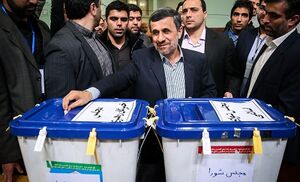
| Year | Election | Votes | % | Rank | Notes |
|---|---|---|---|---|---|
| 1999 | City Council of Tehran | مفقود | |||
| 2000 | Parliament | 280,046 | 9.55 | 68th | مفقود |
| 2005 | President | 5,711,696 | 19.43 | 2nd | Went to run-off |
| President run off | ▲ 17,284,782 | ▲ 61.69 | 1st | فائز | |
| 2009 | President | ▲ 24,527,516 | ▲ 62.63 | 1st | فائز |
| 2017 | President | N/A | Disqualified | ||
| 2021 | President | N/A | Disqualified | ||
| 2024 | President | N/A | Disqualified | ||
Personal life
Ahmadinejad is married, and has one daughter and two sons.[54] His elder son married a daughter of Esfandiar Rahim Mashaei in 2008.[55][56]
Supporters of Ahmadinejad consider him a simple man who leads a modest life.[57] As president, he wanted to continue living in the same house in Tehran his family had been living in until his security advisers insisted that he should move. Ahmadinejad had the antique Persian carpets in the Presidential palace sent to a carpet museum, and opted instead to use inexpensive carpets. He is said to have refused the VIP seat on the presidential plane, and that he eventually replaced it with a cargo plane instead.[58][59] Upon gaining Iran's presidency, Ahmadinejad held his first cabinet meeting in the Imam Reza shrine at Mashhad, an act perceived as "pious".[60] He also used to lay an extra place for the 12th Imam at his weekly cabinet briefings.[61]
See also
- 2006 Iranian sumptuary law controversy
- Advisors to the president: Hamid Mowlana, Mohammad-Ali Ramin, Ali Akbar Javanfekr
- Ayatollah Mohammad-Taqi Mesbah-Yazdi
- Politics of Iran
- Mahmoud Ahmadinejad and Israel
- Electoral history of Mahmoud Ahmadinejad
- Foreign policy of the Mahmoud Ahmadinejad administration
References
- ^ Lucas, Scott (5 January 2015). "Iran Feature: Signs of an Ahmadinejad Comeback & a Hard-Line Challenge to Speaker of Parliament Larijani". EA WorldView. Retrieved 3 June 2016.
- ^ أ ب Peterson, Scott (2010). Let the Swords Encircle Me: Iran: A Journey Behind the Headlines. Simon and Schuster. pp. 279–280. ISBN 978-1416597391.
- ^ أ ب Ehteshami, Anoushiravan; Zweiri, Mahjoob (2007), Iran and the Rise of Its Neoconservatives: The Politics of Tehran's Silent Revolution, I.B.Tauris, p. 55, ISBN 978-0857713674
- ^ Afshon Ostovar (2016). Vanguard of the Imam: Religion, Politics, and Iran's Revolutionary Guards. Oxford University Press. p. 124. ISBN 978-0190491703.
- ^ Pronunciations for محمود احمدینژاد
- ^ Windfuhr, Gernot (1979). Persian Grammar: History and State of Its Study. Walter de Gruyter. p. 145. Archived from the original on 28 October 2013.
...stress is word-final in simple, derived, and compound nouns and adjectives...
- ^ خطأ استشهاد: وسم
<ref>غير صحيح؛ لا نص تم توفيره للمراجع المسماةSabbaghian - ^ "Ahmedinejad: Rose and Thorn". The Diplomatic Observer. Retrieved 27 July 2009.[dead link]
- ^ "Mahmoud Ahmedinejad on Facebook". Facebook. 24 July 2001. Archived from the original on 17 December 2012. Retrieved 27 July 2009.
{{cite web}}: Unknown parameter|dead-url=ignored (|url-status=suggested) (help) - ^ Biography of H.E. Dr. Ahmadi Nejad, Honourable President of Islamic Republic of Iran. Retrieved 27 January 2008. Archived 3 يناير 2008 at the Wayback Machine
- ^ Avideh Mayville, "The Religious Ideology of Reform in Iran" in J. Harold Ellens (ed.), Winning Revolutions: The Psychosocial Dynamics of Revolts for Freedom, Fairness, and Rights [3 volumes], ABC-CLIO (2013), p. 311
- ^ "Mahmoud Ahmadinejad". Iran Chamber Society. Retrieved 28 July 2009.
- ^ McCormick, John (3 February 2009). Comparative Politics in Transition (in الإنجليزية). Cengage Learning. p. 520. ISBN 978-0-495-56852-0.
- ^ Axworthy, Michael (10 March 2016). Revolutionary Iran: A History of the Islamic Republic (in الإنجليزية). Oxford University Press. ISBN 978-0-19-046896-5.
- ^ "Hardline mayor with a humble man-of-the-people image". The Guardian. 20 June 2005. Retrieved 2 October 2023.
- ^ "Ahamd Bozorgian (MP): 'The Separation of men and women's elevators is an advantageous policy. It would help to grow.'". Archived from the original on 14 January 2006. Retrieved 20 June 2005. Entekhab News. Retrieved 31 August 2006.
- ^ "Ahmadinejad Sworn in as Iran's New President". Voice Of America. 6 August 2005. Archived from the original on 29 January 2009. Retrieved 23 December 2008.
- ^ "Iran hardliner becomes president". BBC. 3 August 2005. Retrieved 6 December 2006.
- ^ Hafezi, Parisa. "Influential Iran cleric slams Ahmadinejad on economy" Reuters, 13 August 2008
- ^ Memarian, Omid (17 September 2010). "Activists Warn of Rights Crisis Ahead of Ahmadinejad Visit | Inter Press Service". Ipsnews.net. Inter Press Service. Retrieved 4 March 2020.
The event was organised by two New York-based rights groups, the International Campaign for Human Rights in Iran and Human Rights Watch, as well as the Nobel Women's Initiative. ... His group, "Amnesty International ...
- ^ Tait, Robert (25 May 2007). "Iran interest rate cut sparks panic selling". The Guardian. Tehran. Retrieved 18 June 2011.
- ^ مدیریت و" برنامهریزی منحل شد", BBC Persian. Retrieved 29 July 2007. Archived 17 أغسطس 2007 at the Wayback Machine
- ^ "Assembly of Experts to study economic reform plan: Rafsanjani". Tehran Times (in الفارسية). 23 August 2008. Archived from the original on 12 September 2008. Retrieved 23 August 2008.
- ^ "Iran clerics defy election ruling". BBC News. 5 July 2009. Retrieved 18 June 2011.
- ^ "Is this government legitimate?". BBC. 7 September 2009. Retrieved 18 June 2011.
- ^ Landry, Carole (25 June 2009). "G8 calls on Iran to halt election violence". AFP. Archived from the original on 3 March 2014. Retrieved 18 June 2011.
The West has expressed alarm over Tehran's crackdown ... The Group of Eight leading powers on Friday deplored post-election violence in Iran ... Divergences appeared when Russian Foreign Minister Sergei Lavrov warned that isolating Iran was the "wrong approach" ...
- ^ أ ب Erdbrink, Thomas (3 April 2013). "Power Struggle Is Gripping Iran Ahead of June Election". New York Times. Retrieved 4 April 2013.
It is all part of a power struggle ahead of the June election between Mr. Ahmadinejad's faction and a coalition of traditionalists, including many Revolutionary Guards commanders and hard-line clerics.
- ^ خطأ استشهاد: وسم
<ref>غير صحيح؛ لا نص تم توفيره للمراجع المسماةrift - ^ خطأ استشهاد: وسم
<ref>غير صحيح؛ لا نص تم توفيره للمراجع المسماةaccept - ^ "Iran's president Mahmoud Ahmadinejad summoned to parliament". The Guardian. 14 March 2012. Retrieved 18 December 2012.
- ^ Ahmadinejad critic Larijani re-elected Iran speaker. BBC (5 June 2012). Retrieved on 18 December 2012.
- ^ "Hard-Line Ex-Leader Ahmadinejad Stuns Iran With Election Bid". The New York Times. 12 April 2017.
- ^ "Mahmoud Ahmadinejad 'disqualified' from Iran elections". 20 April 2017.
- ^ "Iran's Ahmadinejad disqualified from running for the president". 20 April 2017.
- ^ Motamedi, Maziar. "Iran approves 7 for presidential vote; bars reformists". Aljazeera.com (in الإنجليزية). Retrieved 2021-07-26.
- ^ "Iran's hard-line former President Mahmoud Ahmadinejad registers for June 28 presidential election". AP News. 2 June 2024.
- ^ "Iran announces six candidates approved for June 28 presidential election". France 24 (in الإنجليزية). 2024-06-09. Retrieved 2024-06-10.
- ^ "السيرة الذاتية لفخامة رئيس الجمهوریة الإسلامیة الإیرانیة الدکتور محمود أحمدي نجاد". الموقع الرسمي للرئاسة الإيرانية.
- ^ "New Iran interior chief approved". BBC News. 18 November 2008. Retrieved 21 June 2009.
- ^ "Iran To Hold Presidential Election In June 2009" (Reuters). Radio Free Europe/Radio Liberty. September 7, 2008. Retrieved 2 December 2008.
{{cite news}}: Check date values in:|date=(help); Unknown parameter|curly=ignored (help) - ^ Erdbrink, Thomas (March 18, 2009). "Khatami Pulls Out of Presidential Race". The Washington Post. Retrieved 2009-03-18.
- ^ "Iran election protests turn violent". CNN. 13 June 2009. Retrieved 13 June 2009.
- ^ أ ب ت . Fars News. 22 June 2009 http://english.farsnews.com. Retrieved 22 June 2009.
{{cite news}}: Missing or empty|title=(help) خطأ استشهاد: وسم<ref>غير صالح؛ الاسم "join" معرف أكثر من مرة بمحتويات مختلفة. - ^ "Iran: A Coup In Three Steps". Forbes.com. 2009-06-15. Retrieved 2009-06-20.
- ^ "Ahmadinejad's Coup D'Etat". Fpif.org. 2009-06-16. Retrieved 2009-06-20.
- ^ "Mehdi Khalaji — Khamenei's Military Coup in Iran". washingtonpost.com. Retrieved 2009-06-20.
- ^ daylife
- ^ "أحمدي نجاد يشيد بالمقاومة ببنت جبيل". الجزيرة نت. 2010-10-14.
- ^ Golnaz Esfandiari (11 August 2010), The Language of Ahmadinejad: 'The Bogeyman Snatched the Boob', Radio Free Europe/Radio Liberty, https://www.rferl.org/a/The_Language_Of_Ahmadinejad_The_Boogeyman_Snatched_The_Boob/2125263.html, retrieved on 1 August 2017
- ^ "Iran's Mahmoud Ahmadinejad can't stop responding to tweets today". The Daily Dot (in الإنجليزية الأمريكية). 16 October 2018. Retrieved 16 October 2018.
- ^ "The curious case of 'woke' Ahmadinejad". The Jerusalem Post. Retrieved 16 October 2018.
- ^ ظریف محبوبترین چهره سیاسی ایران (in الفارسية). Information and Public Opinion Solutions LLC. 24 May 2016. Retrieved 24 May 2016.
- ^ "Iranian Public Opinion on Key National and International Issues" (PDF). Center for International and Security Studies at Maryland (CISSM) & IranPoll.com. January 2017. Archived from the original (PDF) on 9 April 2017. Retrieved 4 April 2017.
- ^ "Bio: Ahmadinejad". JPost. 16 May 2006. Archived from the original on 18 July 2011. Retrieved 18 June 2011.
- ^ Esfandiar Rahim Mashaei: Iran's Next President? Kourosh Rahimkhani PBS 31 March 2011
- ^ "A loyal liability". The Majalla. 22 December 2010. Archived from the original on 21 October 2013. Retrieved 29 June 2013.
- ^ "Khamenei offers implicit support to Ahmadinejad". AFP. 12 May 2009. Archived from the original on 26 October 2011. Retrieved 7 September 2010.
- ^ خطأ استشهاد: وسم
<ref>غير صحيح؛ لا نص تم توفيره للمراجع المسماةJLAnderson - ^ "Africa can Learn from President Mahmoud Ahmadinejad". The African Executive. Archived from the original on 7 July 2011.
- ^ Escobar, Pepe (15 September 2015). "Travels in Ahmadinejadland". Asia Times. Archived from the original on 13 December 2005.
{{cite news}}: CS1 maint: unfit URL (link) - ^ "A modern history of Iran". The Economist. 18 November 2017. Retrieved 18 November 2017.
Notes
- ^ At the time, Revolutionary Guards rejected official ranks for its members and commanders were simply referred to with honorifics such as "brother" or "pasdar" (guard).[4]
- ^ The -[e] is the Izāfa, which is a grammatical marker linking two words together. It is not indicated in writing, and is not part of the name itself, but is pronounced in Persian language when a first and last name are used together.
قراءات إضافية
- Harris, David [1] (2004). The Crisis: the President, the Prophet, and the Shah—1979 and the Coming of Militant Islam. Little, Brown.
{{cite book}}: External link in|author=
وصلات خارجية
- Official website of the President of Iran
- Blog of President Ahmadinejad
- Biography by CIDOB Foundation
- Video Archive of President Ahmadinejad
- Why Ahmadinejad Loves New York on Time.com (a division of TIME Magazine)
- Interview with Ahmadinejad in TIME Magazine
- Apologize to the World Mr. Wallace and Return that Emmy, Representative Press, June 22, 2008, YouTube, Reduced screen, Full screen (4 min 41 sec).
- Hamid Dabashi, On banality and burden, 11-17 October 2007, Al-Ahram Weekly On-line.
- Exclusive interview with President Mahmoud Ahmadinejad of Brian Williams, broadcast live from Tehran, NBC Nightly News, July 28, 2008, NBC (38 min 58 sec).
Preview of this interview: NBC (7 min 17 sec). An overview: NBC (7 min 59 sec).
المصادر
External links
| Find more about محمود أحمدي نجاد at Wikipedia's sister projects | |
| Media from Commons | |
| News stories from Wikinews | |
| Quotations from Wikiquote | |
| Source texts from Wikisource | |
| Database entry Yes on Wikidata | |
- Blog of Former President, Mahmoud Ahmadinejad
- Biography Archived 1 ديسمبر 2007 at the Wayback Machine (in إسپانية) at CIDOB Foundation
- Video Archive of Ahmadinejad during his presidency at Irannegah.com
- Appearances on C-SPAN
- Mahmoud Ahmadinejad على تويتر
- محمود أحمدي نجاد على تلگرام
- محمود أحمدي نجاد على إنستاگرام
- محمود أحمدي نجاد at the Internet Movie Database
- قالب:Guardian topic
- قالب:Haaretztopic
- قالب:Jerusalem Post topic
- محمود أحمدي نجاد collected news and commentary at The New York Times
- People Who Mattered: Mahmoud Ahmadinejad Time, 16 December 2006
- The Results As They Came In, Andrew Sullivan, The Atlantic, 13 June 2009
| مناصب سياسية | ||
|---|---|---|
| سبقه حسين طاهري بصفته حاكم أذربيجان الشرقية |
حاكم أردبيل 1993–1997 |
تبعه حميد طياهي |
| سبقه حسن مالكمدني |
عمدة طهران 2003–2005 |
تبعه محمد باغر غاليباف |
| سبقه محمد خاتمي |
رئيسس إيران 2005–2013 |
تبعه حسن روحكاني |
| مناصب دبلوماسية | ||
| سبقه عبد العزيز بوتفليقة |
رئيس مجموعة 15 2006–2010 |
تبعه ماهندا راجاپاكشا |
| سبقه محمد مرسي |
أمين عام حركة عدم الانحياز 2012–2013 |
تبعه حسن روحاني |
| مناصب حزبية | ||
| لقب حديث تأسيس المنظمة
|
رئيس المقرات الانتخابية لتحالف بناة إيران الإسلامية الانتخابات المحلية 2003 |
تبعه Hossein Fadaei |
- Articles with dead external links from December 2013
- CS1 errors: unsupported parameter
- CS1 الفارسية-language sources (fa)
- CS1 errors: missing title
- CS1 errors: bare URL
- CS1 الإنجليزية الأمريكية-language sources (en-us)
- CS1 uses الفارسية-language script (fa)
- CS1 maint: unfit URL
- الصفحات بخصائص غير محلولة
- Short description is different from Wikidata
- Articles containing فارسية-language text
- مواليد 28 أكتوبر
- مواليد 1956
- شهر الميلاد مختلف في ويكي بيانات
- يوم الميلاد مختلف في ويكي بيانات
- Articles with hatnote templates targeting a nonexistent page
- Pages with empty portal template
- CS1 maint: numeric names: authors list
- Articles with إسپانية-language sources (es)
- Telegram username not in Wikidata
- محمود أحمدي نجاد
- رؤساء إيران
- زعماء وطنيون حاليون
- عمداء طهران
- حكوميون إيرانيون
- مهندسون مدنيون
- مهندوسن إيرانيون
- شيعة إيرانيون
- مناهضون للجهاد
- إيرانيون
- سياسيون إيرانيون


